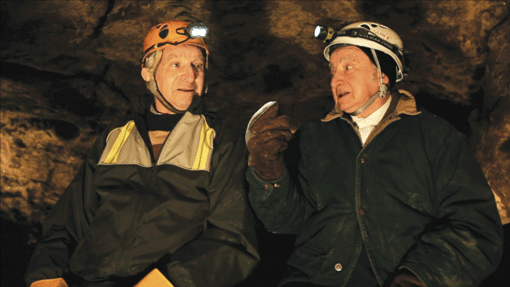No Place on Earth chronicles the remarkable story of the Stermer family and how they survived the Holocaust by hiding in the Ukraine’s deepest caves
By ERIN ELLIOTT BRYAN / Community News Editor
After the breakup of the former Soviet Union, New York-based cave enthusiast Chris Nicola traveled to Ukraine to research his Eastern European family history and to explore the gypsum caves there. Inside the 77-mile-long Priest’s Grotto cave — and more than 70 feet underground — Nicola found objects, such as buttons, shoes, pottery and even beds.
“I had to find out the story of who lived there,” Nicola says in the film.
After years of research and talking to townspeople in Ukraine, Nicola finally located members of the Stermer family, who had survived the Holocaust by hiding in two of the vast underground caves for more than a year and a half.
“I feel like I did something good,” Nicola said. “I went to Ukraine looking for my family’s story and I found someone else’s.”
Nicola’s experience, and the incredible story of family and survival he ultimately uncovered, is chronicled in No Place on Earth, a documentary directed by Janet Tobias.
The film was screened at this year’s Minneapolis Jewish Film Festival, where Nicola spoke, and it will now have a theatrical release, opening Friday, May 3 at the Landmark Edina Cinema.
“Chris is an incredible character, he’s Indiana Jones meets New York state investigator,” Tobias told the AJW. “He’s a relentless investigator and, without him, the story would have stayed within the family.”

Tobias, who spent more than nine years of her childhood living in the Twin Cities (her father was a chemistry professor at the University of Minnesota), has a rich background in storytelling. After graduating from Yale University, she wrote letters to some of the biggest names in network news and was ultimately interviewed and hired by Diane Sawyer.
Tobias worked as a producer and director for Sawyer, and moved with her to ABC to launch Primetime Live. In addition to other projects, Tobias also worked on Dateline at NBC, 60 Minutes at CBS, and Frontline and Nightline at PBS.
“Basically, that whole first portion of my career was an incredibly lucky, perfect training ground for factual storytelling,” Tobias said.
After a career detour to explore the role of technology, Tobias realized that she missed telling stories and put the word out that she was looking to direct a theatrical documentary. A friend insisted she meet Nicola and the Stermer family.
“Honestly, from the time I’ve been at 60 Minutes to the present day, and I’ve been really privileged to hear a lot of great stories, this was one of the best stories I’d ever heard,” Tobias said. “It’s the best adventure survival story I’ve ever heard and I thought, it has to be told.”
In the film, the Stermer family’s experience during World War II is told through dramatic reenactments, which are punctuated by interviews with brothers Saul and Sam Stermer, and their nieces, Sonia and Sima. At the end of the film, all four travel back to Ukraine and revisit the caves that provided shelter for 511 days.
“We had no choice,” Sam Stermer says in the film. “We tried to stick the family together. That was our goal.”

Family matriarch Esther Stermer — whom Tobias describes as a “Golda Meir general” — deserves much of the credit for keeping the family together and alive. She also kept the calendar in her head, knowing when the full moons would take place (the men would not venture outside of the cave in that much light) and even observing the Jewish holidays.
Esther Stermer penned a memoir of her experience after the war, titled We Fight to Survive, which she said she wrote for her grandchildren and great-grandchildren so they would know what the family had been through.
On their trip back to the Ukraine, the Stermers are joined by Sam’s granddaughter, Erin, and his brother Nissel’s grandson, Cliff.
“This is my granddaughter who came to my cave,” Sam says. “That was a one in a million sight.”
Tobias also credits the fact that the family could stay together as one of biggest reasons for their survival.
“The group was much better for depending on each other,” she said. “It took a variety of skills for all those people to make it.”
All told, 28 people took refuge in the first cave, Verteba in the Bilche Zlota Valley, and 38 people descended into the second, Priest’s Grotto — ranging in age from two to 76 years old. They currently hold the record for the longest continuous uninterrupted sustained survival in human history.
The film took more than two years to produce and Tobias said the Ukrainian caves were incredibly difficult to film. Every piece of equipment had to be triple bagged to prevent water damage, and the crew often had to turn sideways to fit through the narrow passageways.
She continues to be amazed by the story, and is inspired by the Stermer family and what they represent.
“They are the best examples I know of people who have had unimaginable things happen to them and have maintained their spirit and dignity and joy in life, and that is incredibly inspiring to be around,” Tobias said. “It’s about what family and friendship can make possible. That at the end of the day, we are better for each other and we can do things that seem completely impossible because of that. That by depending on each other, by relying on each other, we can do truly unimaginable things.”
***
No Place on Earth will open Friday, May 3 at the Landmark Edina Cinema, 3911 W. 50th St. For information, call 952-920-8796 or visit: www.landmarktheatres.com.



















